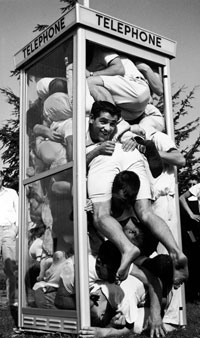
When you’re planning a wireless network, figuring out how many users a wireless access point can host is a very important part of the system design. But, like a lot of things, the answer is complicated. It is kind of like asking “how many people can you fit into a phone booth?” Well that depends on how tall the people are, how much they weigh, their shape and the size and volume of the phone booth. I could put lots of middle school students in the booth versus maybe one member of the Green Bay Packers defensive line unit (my world champion Packers that is).

In Fact, the answer to the capacity question is so complex, most wireless hardware vendors don’t quote those statistics on their marketing materials…typically you only see throughput numbers.
So what should you use as a baseline for wireless capacity planning? And how do you take on large classrooms and high density areas if you don’t know how many users can realistically connect to an access point?
The first thing to understand is that is that not all 802.11n access points are built the same. They typically come in two different flavors: 2x2 MIMO, and 3x3 MIMO access points. The more spatial streams in the access point, the higher the throughput, the higher the throughput, the more users can connect. (Your phone booth is much bigger with a three stream access point vs. a dual stream access point).
Second, there are many variables that affect how many users can connect at one time. Things like what type of applications are they using (streaming media vs. checking email) and what types of devices they are using (multimedia tablets vs. barcode scanners) affect capacity numbers. Just as important is the functionality of the wireless system hardware itself. Some systems are made to load balance users across spectrum, which is a must in a high density environment.
So with those two caveats, you should expect the best, but plan for the worst. I recommend that you be conservative in the capacity planning for your wireless network.
Here are the capacity numbers I recommend for optimal wireless capacity planning broken down by the type of access point you’re using and the type of user environment:

As you can tell from this post, wireless networking is more complex than just putting up a couple of wireless access points. At SecurEdge, we have years of experience designing and installing large scale wireless networks for just about every industry out there. If you need some help, you can request a free consultation with one of our Wireless Design experts at no charge to you. We’ll keep your users from feeling like they’re being packed into a phone booth.






